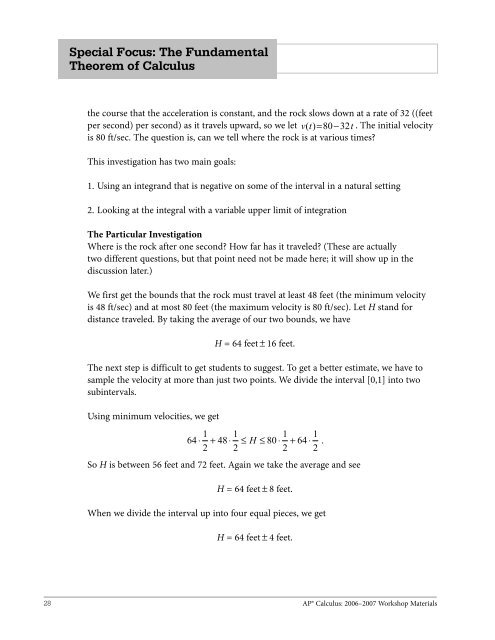AP Calculus
Calculus_SF_Theorem
Calculus_SF_Theorem
You also want an ePaper? Increase the reach of your titles
YUMPU automatically turns print PDFs into web optimized ePapers that Google loves.
Special Focus: The Fundamental<br />
Theorem of <strong>Calculus</strong><br />
the course that the acceleration is constant, and the rock slows down at a rate of 32 ((feet<br />
per second) per second) as it travels upward, so we let v( t)= 80−32 t . The initial velocity<br />
is 80 ft/sec. The question is, can we tell where the rock is at various times?<br />
This investigation has two main goals:<br />
1. Using an integrand that is negative on some of the interval in a natural setting<br />
2. Looking at the integral with a variable upper limit of integration<br />
The Particular Investigation<br />
Where is the rock after one second? How far has it traveled? (These are actually<br />
two different questions, but that point need not be made here; it will show up in the<br />
discussion later.)<br />
We first get the bounds that the rock must travel at least 48 feet (the minimum velocity<br />
is 48 ft/sec) and at most 80 feet (the maximum velocity is 80 ft/sec). Let H stand for<br />
distance traveled. By taking the average of our two bounds, we have<br />
H = 64 feet ± 16 feet.<br />
The next step is difficult to get students to suggest. To get a better estimate, we have to<br />
sample the velocity at more than just two points. We divide the interval [0,1] into two<br />
subintervals.<br />
Using minimum velocities, we get<br />
64 ⋅ 1 + 48⋅ 1 ≤ H ≤ 80 ⋅ 1 + 64 ⋅<br />
1 .<br />
2 2 2 2<br />
So H is between 56 feet and 72 feet. Again we take the average and see<br />
H = 64 feet ± 8 feet.<br />
When we divide the interval up into four equal pieces, we get<br />
H = 64 feet ± 4 feet.<br />
28<br />
<strong>AP</strong>® <strong>Calculus</strong>: 2006–2007 Workshop Materials


